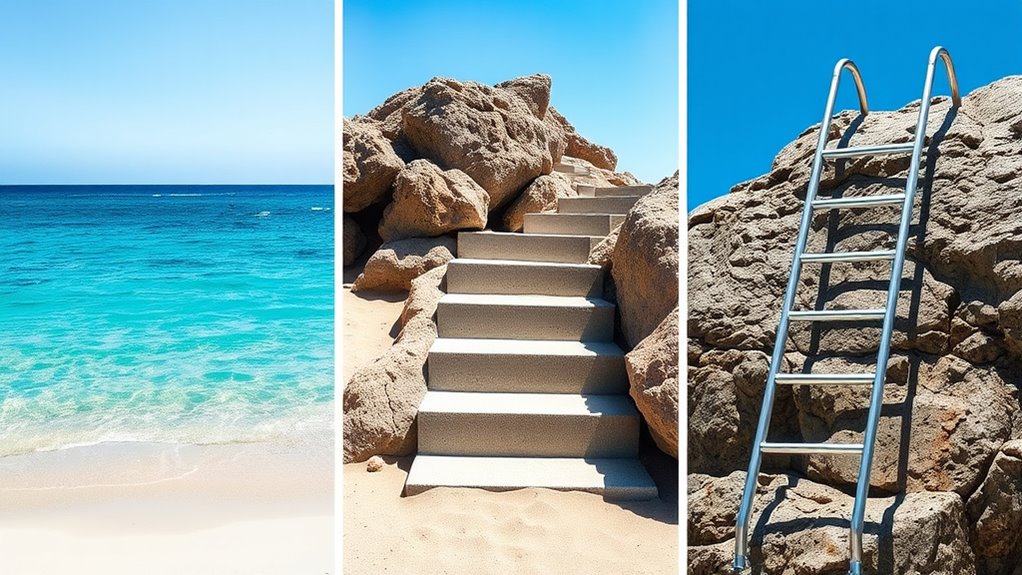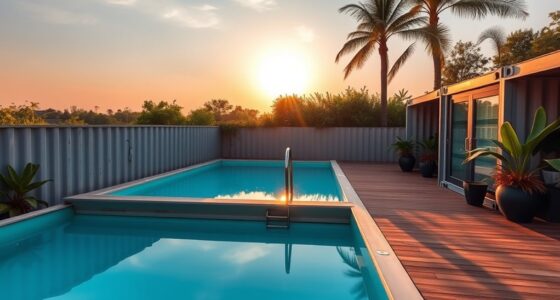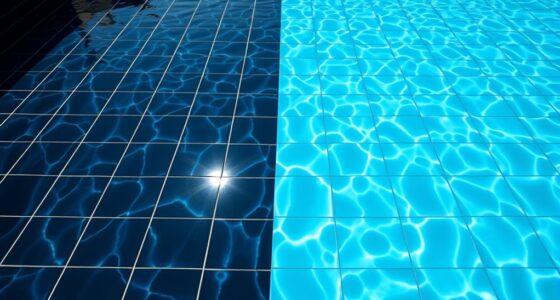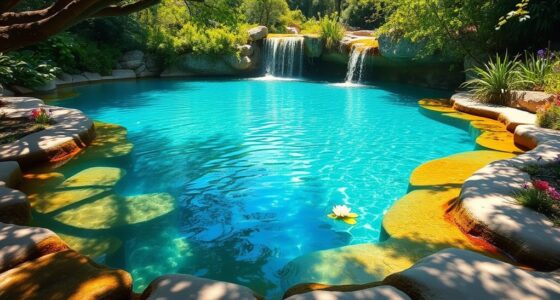Choosing between beach entry, steps, and ladders depends on your needs. Beach entries offer a gradual, natural slope that’s perfect for accessibility and safety, especially for children and seniors. Steps provide a secure progression but require maintenance and are less accessible for some. Ladders are traditional and simple but can pose safety risks if not well-maintained. Understanding these options helps you select the best fit for safety, convenience, and style—discover more details to make an informed decision.
Key Takeaways
- Ladders provide secure grip but pose safety and maintenance issues, especially with corrosion and algae buildup.
- Steps offer gradual access and are suitable for mobility challenges, requiring regular inspections for erosion and wear.
- Beach entries mimic natural shoreline slopes, offering high accessibility but need erosion control and regular cleaning.
- Safety features like textured surfaces and handrails improve security across all options.
- Proper drainage and maintenance are essential to prevent structural damage and ensure safe, long-lasting access.

Accessing the beach can be straightforward or challenging, depending on the design of entry points, steps, and ladders. If you’re planning a beachfront property or a pool area, understanding these options helps you choose the right setup for safety and ease of use. While steps and ladders are common choices, their design impacts not only convenience but also pool safety and maintenance considerations.
Choosing the right access points ensures safety, convenience, and easy maintenance for your beach or pool area.
Ladders are often the traditional choice for pools, especially in commercial or public settings. They provide a secure grip and are easy to use for most people. However, they can pose safety risks if not maintained properly. Corrosion from saltwater, algae buildup, or loose fittings can make ladders slippery or unstable, increasing the risk of accidents. Regular maintenance is essential to keep the ladder secure and safe. This includes checking for rust, tightening bolts, and cleaning off any algae or debris that might make gripping difficult. When it comes to pool safety, ladders should be positioned to prevent accidental falls, especially in shallow areas. Installing non-slip treads or textured surfaces can further reduce slipping hazards, ensuring safer access for children, elderly, or disabled individuals.
Steps offer a different approach, often integrated into the landscape or built as permanent structures. They provide a gradual transition from land to water, which can be especially helpful for those with mobility challenges. Well-designed steps reduce the risk of slips and falls, especially if they’re wide, deep, and equipped with handrails. From a maintenance perspective, steps require routine inspections to prevent erosion or deterioration caused by weather or water exposure. You’ll need to ensure proper drainage so water doesn’t pool on the steps, creating hazards or damaging the structure over time. Additionally, algae, moss, or dirt can accumulate on steps, making cleaning essential for maintaining pool safety standards. Proper drainage and surface texture can significantly enhance safety and longevity.
Beach entry features, often called “zero-entry” or “beach-style” entries, mimic a natural shoreline, gradually sloping into the water. They’re highly accessible, especially for children, elderly, or those with disabilities, and eliminate the need for ladders or steps altogether. From a maintenance perspective, beach entries require careful attention to erosion control, as shifting sands or soil can compromise the slope’s stability. Regular inspections are necessary to prevent uneven surfaces that could cause trips or falls. Also, since debris and algae can settle on the slope, periodic cleaning and monitoring are essential for preserving safety and functionality. Additionally, using Pimple Patches can help treat skin irritation caused by algae or debris buildup around these areas, promoting healthier skin for swimmers.
Frequently Asked Questions
Which Access Option Is Safest for Elderly Users?
For elderly safety, beach entries are the safest access option because they offer better access stability. They typically have a gradual slope, making it easier and safer for seniors to enter and exit the water without risking slips or falls. You should prioritize beach entries to minimize the risk of accidents, especially if your elderly loved ones have mobility issues, ensuring they enjoy the water safely and comfortably.
How Do Maintenance Costs Compare Among the Options?
You might think beach entry options are cheaper to maintain, but actually, they often require less frequent maintenance due to fewer moving parts. Steps tend to need regular repairs and repainting, increasing costs over time. Ladders usually have the lowest maintenance frequency but may need occasional rust treatment. Overall, beach entries typically have a better cost comparison for long-term upkeep, especially if you prioritize durability and minimal maintenance needs.
Can These Options Be Customized for Different Pool Sizes?
Yes, you can customize these access options for different pool sizes. The customization flexibility allows you to tailor design adaptations to fit your specific pool dimensions and aesthetic preferences. Whether you choose beach entries, steps, or ladders, professionals can modify the size, depth, and style to guarantee seamless integration with your pool’s shape and size. This ensures safe, convenient access while enhancing your pool’s overall look and functionality.
Are There Specific Regulations Governing Each Access Type?
Imagine stepping confidently into your pool, knowing safety is a priority. Yes, each access type must meet regulatory compliance and adhere to industry standards to guarantee safety and legality. You should check local building codes and safety regulations for beach entries, steps, and ladders. These rules govern materials, dimensions, and safety features, so your pool remains compliant and safe for everyone, giving you peace of mind with every swim.
How Do These Options Impact Water Circulation and Filtration?
You’ll notice that your pool’s water flow and circulation patterns differ with each access type. Beach entries promote gentle water movement, encouraging better circulation as water flows smoothly across the slope. Steps tend to create more localized circulation zones, while ladders might disrupt flow slightly but allow for quick entry and exit. Considering how each option influences water flow helps optimize filtration, keeping your pool cleaner and ensuring even distribution of chemicals.
Conclusion
No matter which access option you choose—beach entry, steps, or ladders—each offers its own unique charm. Think of it as finding the perfect way to embrace the shoreline’s gentle invitation. With a little patience and an open mind, you’ll discover the approach that feels just right for your adventure. So, take your pick and let the waves guide you, knowing every path holds its own special allure waiting to be explored.









